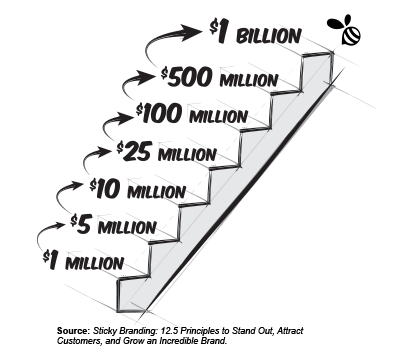Be wary of any business plan that sounds like:
- 25 in 5 ($25 million in 5 years)
- 30 by 30 ($30 million by 2030)
These big goals may sound appealing, but they are rarely achievable.
Picture This Situation
A management consultant leads an executive team through a strategic planning process. It was a busy morning. The team conducted a SWAT analysis and achieved clarity on the company’s competitive advantages.
During the afternoon session the consultant poses a question to the group, “Where do you see your business in 5 years? What’s your goal?”
The team ponders the question and suggests, “We want to double our revenue to $24 million.” The consultant counters, “That’s not big enough. Think bigger! What’s your BHAG — your Big Hairy Audacious Goal?”
The team gives it some more thought and replies, “How about $50 million?” The consultant pounces, “That’s it. Now you’re cooking with gas. That’s a BHAG! And I’ve got the perfect name for your goal, ’50 in 5.'”
The team rallies around the idea. “50 in 5” has a nice ring to it. It is clear, specific, and motivating. And it is big. To achieve the goal the company will have to grow by more than 400% in 5 years.
In the energy of the moment the big goal sounds amazing, but it’s not enough.
Goals Are Nothing Without the Work
A big goal is a destination. It’s what you want. Strategies are how you achieve your big goals.
“50 in 5” is a good starting point for defining a goal, but it’s not a business strategy. It’s a milestone. Where is the rest of the strategy?
- What areas of your business are you working on?
- Why is the goal important for not only your business, but for your customers? What’s the “why” behind your strategy?
- Is the milestone achievable? The number sounds exciting, but does your company have the infrastructure and resources to achieve the goal? If not, how will you build them? If you do, why hasn’t your company already achieved the goal?
Crossing Revenue Plateaus is Fraught with Risk
Growing a company to $25-, $30- or $50 million is an admirable goal, but the journey is fraught with risks.
 Companies grow through predictable revenue plateaus: $1 million, $5 million, $10 million, $25 million, $100 million, $500 million, $1 billion. At each level, growth can slow down or stall.
Companies grow through predictable revenue plateaus: $1 million, $5 million, $10 million, $25 million, $100 million, $500 million, $1 billion. At each level, growth can slow down or stall.
To break free of these plateaus involves a major shift for the business. It requires investing in the infrastructure of the next level (business processes, talent, systems, operations, sales, marketing).
“30 by 30” or “50 in 5” does not prepare your team for what’s ahead.
Going from $5 million, or even $25 million, to $50 million in a short period of time is transformational, and the journey consumes enormous resources to facilitate this level of growth.
Unachievable Goals Destroy Credibility
A number-based goal is only motivating when your company is on track. If your company is growing quickly and on pace to achieve “50 in 5,” it’s a motivating goal.
As soon as you hit a bump in the road the phrase can haunt you:
- If you fall behind, the number becomes even more daunting.
- The team can rebel if crossing a revenue plateau is too painful or expensive.
- The leadership team can lose credibility if the organization fails to stay on pace, or misses the goal entirely.
I’ll repeat it. “50 in 5” or “30 by 30” are effective milestones, but they are not business strategies.
Teams Need a “Why” to Change
The biggest problem with number-based goals is they don’t inform your team on how to act.
Growing through the revenue plateaus puts a lot of pressure on your team, and they need to clearly understand why changing their behaviors, skills, and jobs are so important. “50 in 5” does not explain why change is important for the business.
Delve further into your goals, and ask why a desired revenue target is important for you and your customers:
- What will achieving the goal mean for your customers?
- How will achieving the goal change your industry, and the way business is conducted?
- Why is it important for your company to reach this goal?
These are the questions your employees need answers for. The number-based goal may sound great at a management retreat, but its residual impact is limited. The number does not engage your people’s hearts. It does not tell them how to act, or why they should change their behaviors.
Your team needs to understand what it means to achieve the goal. They need to know why their contributions matter.
Clear Thinking Drives Results
Effective business strategies have depth, and clearly articulate three things:
- What your company wants.
- Why your company wants to achieve its objectives.
- How it will get there.
The more clearly you can articulate the how and the why the more likely you’ll achieve what you want.





